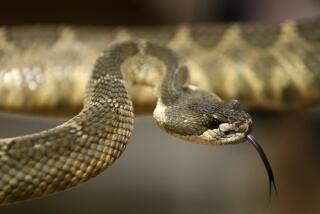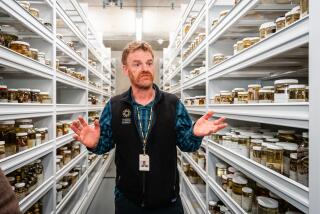Ex-Police Officer in Ohio Turns Lifelong Love of Snakes Into Educational Hobby
- Share via
TROY, Ohio — Maybe it’s the cobra candlesticks, the ceramic snake or the subtropical heat in the house, but it’s clear that Jim Harrison is a different kind of guy.
Most likely, it’s the rows of plexiglass cages, stacked floor to ceiling, each with a copperhead, rattlesnake, cottonmouth, cobra, python--or any of the other 150 snakes that Harrison calls housemates.
“I want people to learn to live with them, coexist with them. . . . People go out of their way to kill snakes,” Harrison said.
So Harrison, 29, a former police officer, offers to go anywhere within 100 miles to collect wayward reptiles.
In 1983 he made headlines by capturing a pet cobra in a Dayton garage. He recently went to Greene County when a missing 10-foot Burmese python was found in a shed. Harrison says he has been called 50 to 60 times during the last four years.
Harrison doesn’t want a “Jungle Jim” image. He does it “for the protection of the snake, for the protection of the people, for the protection of the legitimate herpetologists.”
He also has been interviewed so many times, both by reporters and by the children entranced by the snakes he brings to their schools, that he knows most of the questions beforehand.
At age 6 he caught a garter snake, and at 12 a timber rattler.
“That one I turned loose. My mom had a fit,” he said. “My dad, as long as it was non-venomous, he didn’t care.”
Harrison caught the rattler in the Tennessee hills where he said he had met an old man who caught them with his bare hands and sold them to religious groups.
“He taught me how to handle and manipulate snakes,” Harrison said, although he remembered the man later died after being bitten.
Harrison has been bitten three times, twice by copperheads and once by a Mexico viper. No venom was injected the first two times.
But a year ago, a copperhead injected venom, and within a day his right arm was swollen up to his shoulder. He spent five days in the hospital.
“I lost an inch or two off my bicep because of the digestion (of the venom). It’s like meat tenderizer,” Harrison said. He still has tendinitis in the elbow.
Most snake venom isn’t powerful enough to kill a grown person, Harrison said; insect venom is much more powerful. But Harrison also said he was not paying attention when he was bitten and shouldn’t have been handling the snake.
He says the only reason he can understand why some people own venomous snakes for pets is that “some people are on a macho trip.” He opposes that and wishes that Ohio would require permits for owners restricting their use to research.
He has 49 species of snakes in cages stacked in three upstairs bedrooms. Harrison used to sleep in the fourth, but he moved downstairs to make more room for the snakes. After all, when a Wagler’s tree viper or a Cambridge rattler wants to move in, who’s to argue?
There are red lights to help winter hibernation, and one room is air conditioned in winter so native snakes sleep easily.
In other rooms, extra heaters push the temperature to 90 degrees for tropical snakes.
In one room, Skippy, a cobra, bangs against the plastic cage, and a visitor instinctively steps back. Harrison got the snake from a Florida reptile farm.
“He was a little aggressive for the display,” Harrison said.
But most snakes are not aggressive, unless you run across them during their nighttime feedings, he said.
Harrison retired after three years as a police officer when a car hit him and wrecked his knee. He lives off a police pension and money he collects giving karate lessons and snake shows.
“I’m not making a profit at this yet. This is just a hobby for now,” he said.
Someday, he’d like to own a small museum, or at least a van for his educational shows.
More to Read
Sign up for Essential California
The most important California stories and recommendations in your inbox every morning.
You may occasionally receive promotional content from the Los Angeles Times.










